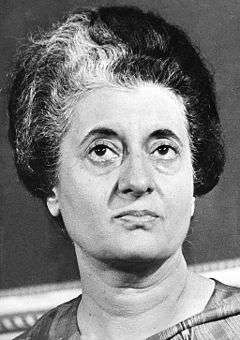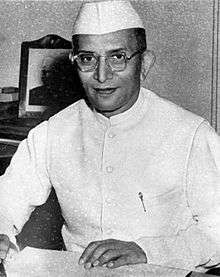Indian general election, 1971
| | |||||||||||||||||||||||||||||||||||||||||
| |||||||||||||||||||||||||||||||||||||||||
| |||||||||||||||||||||||||||||||||||||||||
| |||||||||||||||||||||||||||||||||||||||||
India held general elections to the 5th Lok Sabha in March 1971. This was the fifth election since independence in 1947. The 27 Indian states and union territories were represented by 518 constituencies, each with a single seat.[2] Under the leadership of Indira Gandhi, the Indian National Congress (R) led a campaign which focussed on reducing poverty and won a landslide victory, overcoming a split in the party and regaining many of the seats lost in the previous election.
During her previous term, there had been internal divisions in the Indian National Congress between Indira Gandhi and the party establishment, especially Morarji Desai. In 1969, she was expelled from the party, causing a split. Most of the Congress MPs and grassroots support joined Gandhi's Indian National Congress (R) faction, which was recognised by the Election Commission as being the successor to the previous party. 31 MPs who opposed Gandhi became the Indian National Congress (Organization) party. Despite the split, the Ruling faction gained votes and seats to win a strong majority, whereas the Organization faction lost half of their seats.
On 12 June 1975, the Allahabad High Court invalidated the result in Gandhi's constituency on the grounds of electoral malpractices. Instead of resigning, Indira Gandhi called a state of emergency, suspending democracy and outlawed political opposition. After democracy was restored in 1977, the opposition Congress faction formed a coalition of parties called the Janata Party, which inflicted the Congress' first electoral defeat.
Results
Results by alliance
| Alliances | Party | Seats won | Change | Popular Votes % |
|---|---|---|---|---|
| Indian National Congress (R) Seats: 350 Seat Change: +93 Popular Vote %: 43.68 |
Indian National Congress (R) | 352 | +93 | 43.68 |
| National Democratic Front (Alliance) Seats: 51 Seat Change: -65 Popular Vote %: 24.34 |
Indian National Congress (Organisation) | 16 | −17 | 10.43 |
| Bharatiya Jana Sangh | 22 | -22 | 7.37 | |
| Swatantra Party | 8 | -15 | 3.07 | |
| Samyukta Socialist Party | 3 | -10 | 2.43 | |
| Praja Socialist Party | 2 | -17 | 1.04 | |
| Left Parties Seats: 48 Popular Vote %: 9.86 |
Communist Party of India (Marxist) | 25 | -6 | 5.13 |
| Communist Party of India | 23 | — | 4.73 | |
| Others Seats: 66 Popular Vote %: 22.14 |
Others | 67 | -12 | 22.16 |
Results by Party
See also
- State Assembly elections in India, 1971
- Election Commission of India
- Indian presidential election, 1969
References
- ↑ http://www.ipu.org/parline-e/reports/arc/INDIA_1971_E.PDF
- ↑ "General Election of India 1971, 5th Lok Sabha" (PDF). Election Commission of India. p. 6. Retrieved 13 January 2010.

